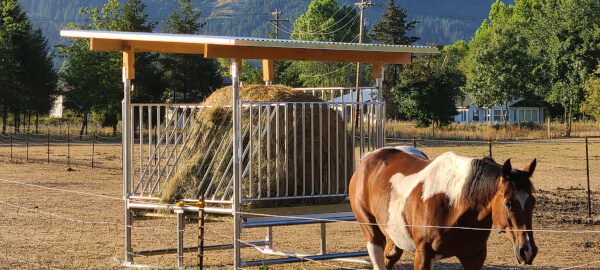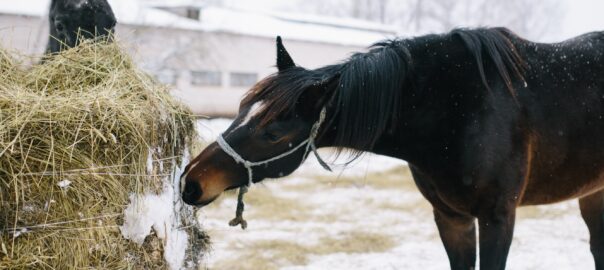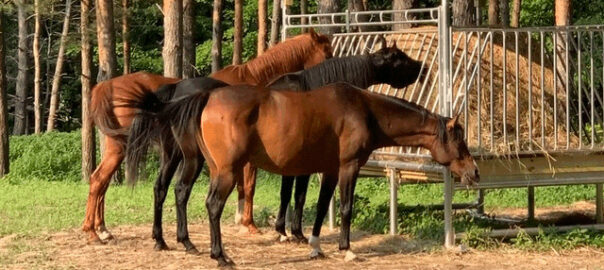Feeding horses hay might seem simple, but choosing the right amount and type is one of the most important decisions you can make for your horse’s health. Hay forms the foundation of every horse’s diet, providing essential fiber, energy, and nutrients that keep the digestive system working smoothly. This can be crucial for maintaining good health and preventing health problems, such as horse colic.
How Much Hay Should a Horse Eat?
As a rule of thumb, most adult horses should eat 1.5%–2.5% of their body weight in hay (dry matter) each day.
- A 1,000-pound (450-kg) horse needs 15–25 pounds of hay per day.
- Horses that feed on rich pasture may do better with the lower end of that amount.
- Performance horses, growing horses, or those in cold climates often need more hay..
Hay Should Be Measured in Weight – Not Scoops
Always weigh your hay instead of guessing by handfuls. Hay density can vary by bale type and forage type. A “flake” of light, fluffy grass hay can weigh half as much as one from a dense alfalfa bale, which can throw feeding estimates off by several pounds a day.
How to Adjust for Hay Amounts Your Horse’s Needs
Every horse is different. The right amount of hay depends on:
- Body condition score (BCS): Keep most horses between a 4 and 6 on the Henneke scale.
- Workload: Horses in moderate to heavy exercise burn more calories and may need additional hay or supplemental grain.
- Weather: In cold or wet conditions, horses use extra energy to stay warm, increasing hay needs.
Choosing the Best Type of Hay
Hay quality is not just about appearance; the type of forage, harvest, storage conditions, and nutrient balance all affect how nutritious and safe it is.
Grass Hays — Ideal for Most Horses
Pros: Lower in protein and calories than legumes; good for maintenance or light work.
Best for: Easy keepers, ponies, and horses prone to laminitis or metabolic issues.
Legume Hays — High Protein, High Energy
Pros: Rich in protein, calcium, and calories — great for growing, lactating, or hard-working horses.
Cons: Too rich for idle or overweight horses.
Best for: Performance horses, broodmares, underweight or growing horses.
Mixed Grass-Legume Hays — Balanced Nutrition
Pros: Offers a good middle ground — more protein than grass hay but less than pure alfalfa.
Best for: Most horses, especially if you’re feeding a variety of activity levels.
How to Tell if Hay is High Quality
Good quality hay should:
- Smell fresh and slightly sweet — never musty or moldy.
- Feel soft and pliable, not brittle or coarse.
- It should contain mostly leaves, since that’s where most nutrients are stored.
- Be free of weeds, debris, or excessive dust.
Feeding Your Horses Outdoors
If feeding your horses outdoors, a hay saver feeder is a good option for maintaining hay quality and preventing waste. You can easily add a roof to the hay saver feeder, helping to further protect your hay feed from the elements.
Storing Hay
To maintain quality between feedings, horse hay should be stored in a dry, well-ventilated area. Hay needs protection from moisture (both rain and condensation) and good airflow to prevent trapped heat.
Feeding your horse the right hay — in the right amount — is one of the simplest yet best ways to keep your horse healthy, happy, and performing at their best. Start with high-quality forage, feed by weight not scoop, and make adjustments based on your horse’s body condition and workload. When in doubt, consult an equine nutritionist or veterinarian — a little expert input can make a big difference in your horse’s long-term health and longevity.




